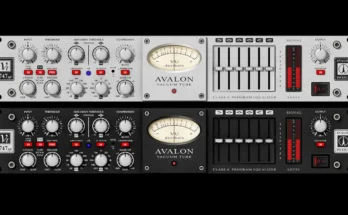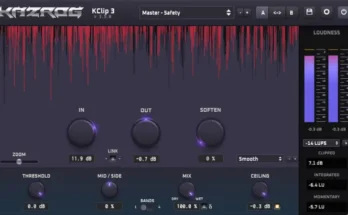Sonicrusher v1.0.0 WiN [FREE]
FREE | WiN | 6.45 MB
Linda Audio releases Sonicrusher – versatile compressor plugin with some extra features. Sonicrusher does not model any real hardware but it is capable of everything from gentle transparent compression to extreme compression that will smack your drums hard. It can be run in Modern level detector mode (feed-forward) for fast and hard transient shaping, or Vintage (feed-back) detector mode which is more gentle. It has adjustable knee and RMS and of course hi-pass (and even lo-pass) sidechain filter. It can work also in “Split” mode, which compresses high frequencies separately with slightly different parameters (It is useful for example on vocals or on some synths). One other special feature is “Crush” – band-pass or hi-pass filter with overdrive which can add some life back to the compressed signal and even can be controlled by actual compression. There is also clipper with adjustable threshold, and dry/wet mix. Automatic gain compensation is also available.
Sonicrusher has three parts: compressor, crush/color section and output section.
1) Compressor
DRIVE – input gain in dB. Affects the level of input signal which also affects how much overdrive occurs in Crush and Warm sections. -40 to +18 dB.
THRESHOLD – level of signal where the compression starts. Its behavior is dependent on fat/tight, pumping/solid and modern/vintage settings.
RATIO – how much is the signal attenuated after the attack time. From 1:1.25 to 1:32.
ATTACK – length of the attack phase (from zero compression to 1:RATIO compression). From fast to slow.
RELEASE – length of the release phase. Release phase starts when the signal goes below threshold again. From fast to slow.
HOLD – time that keeps compression even if the signal is bellow threshold in milliseconds. 0 to 500ms.
HI-PASS – hi-pass filter of the detector signal. Off or from 20Hz to 500Hz.
LO-PASS – lo-pass filter of the detector signal. Off or from 22KHz to 400Hz.
KNEE – the size of the compression knee rounding. At zero it is hard knee.
RMS – length of the window for averaging input signal value. With RMS at zero it is the peak detection and the bigger RMS, the more energy is needed for compression to start. It is useful for example for harder drum transient shaping.
FAT/TIGHT – affects the curve of the compression and the threshold. TIGHT is more snappy and distinct compression while FAT is fatter and more stable.
PUMPING/SOLID – PUMPING is faster and more pumping compression, SOLID is more stable and less pumping compression.
MODERN/VINTAGE – in MODERN mode the signal detector works in feed-forward mode, while in VINTAGE it works in feed-back mode which usually provides more gentle and smooth compression.
HF SPLIT – compresses hi frequencies separately with slightly different parameters (It is useful for example on vocals or on some synths). HF knob controls how much high frequencies are mixed back to the signal.
2) Crush/color section
CRUSH – adds band-passed or hi-passed compressed signal which is sent through non-linear distortion and mixed back. The distortion is dependent on the input signal, Drive and Crush.
CRUSH FREQ – crush filter frequency. 30Hz to 12KHz.
CRUSH Q – crush filter width.
HP/BP – crush filter type – hi-pass or band-pass.
ENV ON/OFF – when ENV is ON crush is controlled by actual compression (for example only on drum transients). With ENV OFF crush is constant.
WARM – adds another harmonic distortion. It is dependent on input signal level and on DRIVE.
COLOR – connected lo-shelf and hi-shelf filters which allows to darken or lighten the processed signal.
3) Output section
ST. LINK – with ST. LINK ON the detector signal is average of left and right. With ST. LINK OFF detector for each channel is computed separately. In fact this belongs more to the compressor section.
CLIP – enables hard clipping. Everything above clip thresh is trimmed to this level.
CLIP THRESH – level above that the output signal is trimmed.
OUTPUT – output level in dB. -40 to +24 dB.
DRY/WET – mix of dry and processed signal. Dry signal is not affected by Drive, but it is affected by Output.
AUTOGAIN – it has two variants. 1) STATIC, compensates compression constantly and relatively to Threshold, Ratio, Drive, Attack, Release and Hi-pass. It does not affect the compression. But it is not accurate, it always depends on specific input material and its compression. 2) DYNAMIC – works very accurate on every material, but it is in fact another level of slow compression with long RMS window and it does affect the overall compression. AUTOGAIN can be switched off.
BYPASS – global bypass.
Metering
There are also signal meters in the left part. Input and output level and level reduction meter showing values in dB. Each meter highlights maximum value for two seconds.
Please REPORT in Comment Broken Links




